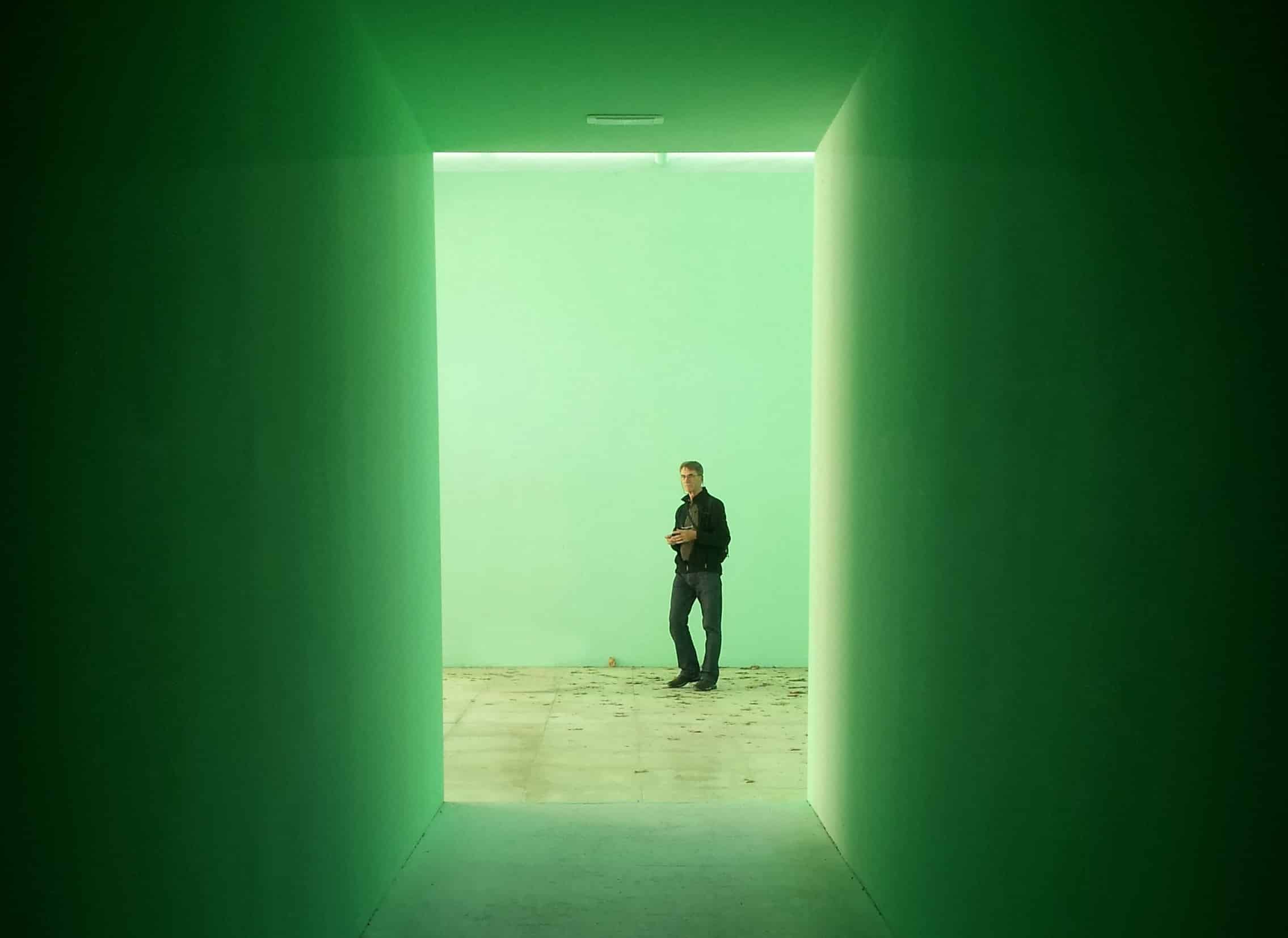Make people go deeper into your world.
We all carry symbols within us. Symbols like parenthood, gender, blue collars, a country’s flag, a cross on a hill or a grad school pin.
These are symbols that, regardless of place or context, will make us feel something when we encounter them.
In some cases those symbols alter our mental state. There is a measurable change between the person we were before we encountered the symbol, and the person we became after it.
When symbols change us emotionally, they become powerful thresholds.
One of the symbolic thresholds that has always had a profound effect on me is the Japanese torii.
A torii is a freestanding gate that symbolizes transition — from human to sacred, from the known world to the secret world. It is a border between the visible and invisible, and for all of its simplicity and detachment, it carries a gravity that I haven’t experienced in any other symbolic threshold in my work.

When I first learned about torii in an art history course over a decade ago, it wasn’t the structure itself that struck me but rather the power it carried outside of place or time.
While torii are typically placed at the entrance of Shinto shrines, they also appear in completely secluded locales. You may see one in an empty field, a forest, or outside of Japan altogether, but no matter where it is, it’s meant to mark a path for transition.
That is the significance that was imputed on this structure. It is created over and over again to exist outside of any specific time or place, and there are very few other symbols that operate in the same way.
It is not the space that makes the torii meaningful, it is the torii that makes the space meaningful.
Thresholds change the context around them.
I’ve seen them in Japan, in French museums, and standing tall in barren cattle ranches in southern California… and in all of these places, the torii created an emotional threshold that framed my experience of the world around me.
There is a lesson here in how thresholds mold the human experience and how they are different from every other kind of touch point we experience in our lives as users.
For brands, a threshold is an opportunity to create meaning where there once was none.
What It Means To Create A Brand Threshold
A $2.6 billion industry has popped up around subscription products, and 55% of that growth is attributed to a newly popularized brand threshold we’re all familiar with by now: unboxing.
There are now 3,500 subscription box offerings in the US market, all with markedly different business models.
Some, like Birchbox, use the subscription box as an upsell to full sized products on their website.
Ipsy takes a different route and uses beauty and lifestyle influencers to create content that generates ad revenue on top of the actual product.
FabFitFun makes a healthy margin off of sponsored products, and Sephora blends the sponsored model with straightforward sales.
It is not the convenience, the price point or the novelty that has propelled these brands to success. In fact, many boxes have wildly different price points irrespective of value-for-price, many do not allow customization, and at this point, what novelty can be left?
It is the emotional threshold of unboxing that has moved the subscription box industry into the mainstream.
As Elizabeth Segran of Fast Company puts it, “It hinges on a business model that goes beyond making money on the box itself, and investing in content that makes the unboxing experience exciting every single time.” [Emphasis added.]
Unboxing is an emotional threshold that has been iterated, perfected and monetized for maximum effect. A good unboxing creates a clear transition from before the event to after. People feel changed after an unboxing.
Every time your brand compels a user to increase their engagement in order to receive an emotional reward, you are creating a threshold.
Emotional brand thresholds promise a changed user on the other side.
Your user has to make a choice to move through that threshold and experience the change. It is in these critical mass moments that people move deeper into the brand, and they operate on 3 principles:
- Investment. Thresholds always come with an upfront cost of time, money or effort on behalf of the user and the brand. For an Ipsy box, all of these investments come into play.
- Change. There needs to be a before-and-after change in emotional state. Unboxing isn’t about the products you get, it’s about the anticipation of the reveal, the payoff and the euphoria afterward. In this case, it is also about the promise of who you will become with this new arsenal of goods.
- Message. A strong threshold is a very powerful branding moment. It communicates the brand position in action, not words. There needs to be a message that comes through, and in Ipsy’s case, it’s a message about playing with beauty.
These rules can help you turn certain touch points into positive thresholds. They also mean that not all customer touch points are thresholds to begin with.
Sponsored gift bags at an event, for example, are not thresholds. There is no directly related upfront cost for the user, and no unified message.
Customer service, thank you emails, subscription pages, POS gimmicks, videos and content usually aren’t thresholds either. They may employ one of the principles above, but not all three.
Touch points are simply a time and place when your brand touches the consumer, wherever they are.
Thresholds are an occasion where you and the user both agree to meet someplace new, and to leave in an altered state.
Different Portals For Different Needs
The Ordinary skincare brand, for all of its drama and troubles, has been extremely clever in creating thresholds that move users deeper and deeper into their brand world. Fans have to travel through a series of costly portals in order to get the emotional reward they are seeking.
One of these thresholds is their extremely active and engaged Facebook group managed by users. It’s a private group that you actually have to apply to get into by answering some questions about yourself.
Once you’re in, you’re thrust into a world of acronyms, coded language, intimately revealing skin photographs, excel spreadsheets for experimenting with different regimens, documents and fervent followers that will push you even further out of your comfort zone and demand an increased investment in time and effort. This is a new space that both you and the brand are agreeing to meet in.
If you want to learn about skincare like a dermatologist, you have to educate yourself in The Ordinary’s world. And if you don’t, you’re not welcome here.
It’s a steep price to pay, but believe me, once you successfully pass that threshold you are a changed person with a changed relationship to their skin.
For the frustrated legions of women who have tried everything to get their skin better, it is an emotional reward they are willing to pay upfront for.
And it is that stretch between the investment and the reward/ change that leaves users wide open to the brand’s message — ‘The beauty industry is ugly. We’ve found a new way.’
Thresholds force us to suspend our biases and be open to a new message. They’re moments of change that allow us to accept fresh ideas in place of old ones.
One of the best times to have your brand message heard is when your user is going through a transition.
Everything about The Ordinary’s threshold creates a sacred space with promise and evolution… and that’s the best time to form new beliefs. That is precisely when the message comes through.
A threshold happens when both the brand and user are drawn closer together because both have opted to take a voluntary step toward each other. The user invests their time/ money/ attention, while the brand invests in a sort of wall, where not everyone is let through, but those who are get that emotional change.
You can look at it as a test, a boundary, a wall or a step. It can take many forms. What is consistent across all of them, however, is that not everyone will pass. Those who do will be changed on the other side.
Places Where Thresholds Can Appear
If you’re hard pressed to find examples of thresholds in your own brand or others’, you’re right. Brands are starting to understand the significance of these moments and it’s a tactical device that has been historically underutilized.
Many things come close to being a threshold, but don’t quite get there. Traditions like the Jeep Wave in the US or John Lewis’ holiday ads and the Coca Cola Truck in the UK, tribal gatherings like SoulCycle and Tracy Anderson cults, or any other number of unofficial events we care about as consumers.
But with the right thinking and perspective, there are a few key touch points that could be turned into thresholds:
- Store Entrances: Literally the physical threshold that users pass through every day. The best, most experiential storefronts get the message right, and can affect at least somewhat of an emotional change, but almost none can balance it with some sort of upfront investment for the user. Popups are perhaps the only thing that come close.
- Product Drops: Yes there is an investment, but the message and emotional change usually fall short. At best, you have brands like Supreme that create a flex-focused brotherhood, but it’s more akin to a game than an exchange.
- Events and Pilgrimages: Everyone understands how to create an immersive, on-brand experience. And of course there is the cost of traveling and attending, but what is really missing is the emotional change. Many brands create an experience for the sake of experience — delight, fun, indulgence — but can they really say that their users leave as changed people?
- Announcements and Product Discovery: Again, do brands balance all three principles when it comes to announcing a product or creating a sense of discovery around their new offerings? There is no upfront investment before the actual cost of the product itself. The message may be there, but there likely won’t be a before-and-after emotional state for the user.
Thresholds are not easy to create.
They require a totally different lens through which to see your users interactions with your brand. But when they do appear, they are powerful engagement machines.
Questions To Ask Yourself
With the right thinking, mundane touch points can be turned into thresholds that follow the three main principles that all thresholds follow.
Start by asking yourself the kinds of questions that will lead you to that critical user interaction:
- What emotional change or arc are we capable of creating in our users? What emotional arc is best aligned with our brand?
- How can we create an upfront cost in those touch points that will a) only draw committed users, and b) amplify the value of the reward?
- What theme or message needs to be integral to the experience in order to communicate our brand identity?
- Where are our users looking for more meaning in the brand experience?
- What are the emotional ups and downs they go through in the overall UX, and how can we turn those points into thresholds?
Remember, the point is to gently push users deeper into your world with every gate that they have to pass through. If those gates are solid, they will begin to take on a life of their own and hold a meaning that is as big as your brand.
Crossing a threshold is about taking a risk and accepting the change that lies on the other side. Just like any relationship, the one that your user makes with your brand is strengthened by these moments.
Use them wisely. Sometimes creating a boundary around your world helps ensure that your true users can find a meaningful way in.




